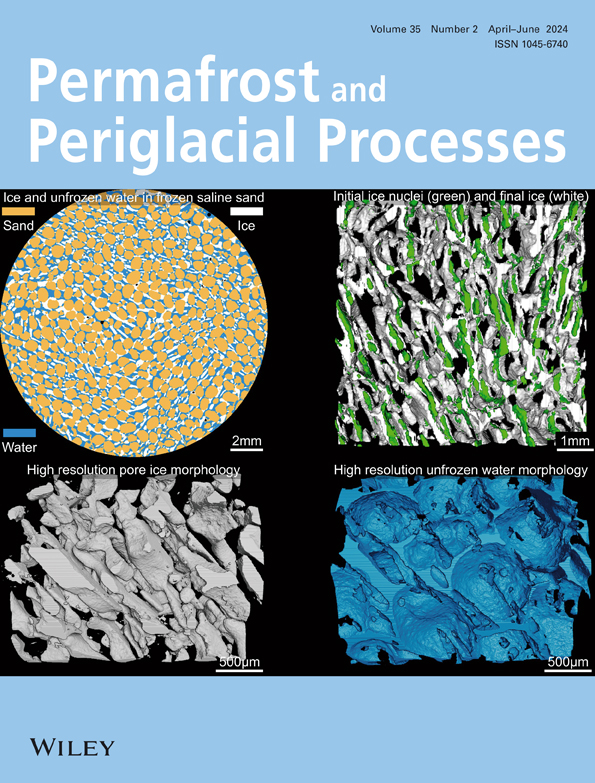阿根廷安第斯山脉中部冰缘土壤的热模拟
IF 3.3
3区 地球科学
Q2 GEOGRAPHY, PHYSICAL
引用次数: 0
摘要
岩石冰川是阿根廷圣胡安安第斯山脉中部最常见的安第斯冰缘地貌。它们的活动层为砾石状,具有典型的开口结构。这些岩石冰川的上部是粗粒度的湍流冰原,没有植被覆盖。自2018年3月以来,对“Candidato”岩石冰川活动层粗土(31.9°S, 70.18°W)进行了监测。三条战壕,海拔4000米。在90厘米深的地方,都装有传感器来测量土壤温度和体积含水量。我们还测量了土壤样品的粒径分布,并计算了土壤样品的热特性。冻土和未冻土的平均导热系数分别为0.69和0.54 W m−1 K−1,平均热扩散系数分别为2.05 × 10−7和1.64 × 10 - 7 m2 s−1。分析活动层的季节性热通量和水文通量是具有挑战性的,因为物理性质是周期性变化的,从而控制着诸如水储存、渗透和渗漏、热平衡、机械行为和运动学响应等过程。我们使用土壤-植物-大气系统(COUP)数值计算机模型的耦合传热传质模型,执行特定地点的校准,模拟土壤温度、活动层厚度和季节性冻融深度。所实施的模型与对气象数据系列的再分析相结合,能够很好地再现放置在地面上的热传感器的数据。这种建议的方法对于仪器有限或可达性低的地区是可行的。“Candidato”岩石冰川可作为该地区流纹岩冰川热模拟的试点模型。本文章由计算机程序翻译,如有差异,请以英文原文为准。
Thermal simulations on periglacial soils of the Central Andes, Argentina
Rock glaciers are the most common landforms of the Andean periglacial landscape in the Central Andes of San Juan, Argentina. Their active layer is gravelly with a typical openwork structure. The upper parts of these rock glaciers are coarse‐grained Turbic Cryosols, with no vegetation cover. Since March 2018, coarse soils in the active layer of the “Candidato” rock glacier have been monitored (31.9°S, 70.18°W). Three trenches, 4,000 m a.s.l. and down to a depth of 90 cm, were equipped with sensors to measure soil temperature and volumetric water content. We also measured particle size distributions and calculated thermal properties from soil samples. The mean thermal conductivities for unfrozen and frozen soils were 0.69 and 0.54 W m−1 K−1, respectively, and the mean thermal diffusivities were 2.05 × 10−7 and 1.64 × 10–7 m2 s−1, respectively. Analysis of the seasonal thermal and hydrological fluxes in the active layer is challenging, as the physical properties change cyclically, thus controlling processes such as water storage, infiltration and seepage, heat balance, mechanical behavior, and kinematic response. We used the Coupled Heat and Mass Transfer Model for the Soil–Plant–Atmosphere System (COUP) numerical computerized model, performing a site‐specific calibration, to simulate soil temperatures, active layer thicknesses, and seasonal freezing–thawing depths. The model implemented, in combination with a reanalysis of the meteorological data series, performed very well to reproduce the data from thermo‐sensors placed in the ground. This proposed methodology is viable for areas with limited instrumentation or low accessibility. The “Candidato” rock glacier can be used as a pilot model for thermal modeling purposes on rhyolitic rock glaciers in the region.
求助全文
通过发布文献求助,成功后即可免费获取论文全文。
去求助
来源期刊
CiteScore
9.70
自引率
8.00%
发文量
43
审稿时长
>12 weeks
期刊介绍:
Permafrost and Periglacial Processes is an international journal dedicated to the rapid publication of scientific and technical papers concerned with earth surface cryogenic processes, landforms and sediments present in a variety of (Sub) Arctic, Antarctic and High Mountain environments. It provides an efficient vehicle of communication amongst those with an interest in the cold, non-glacial geosciences. The focus is on (1) original research based on geomorphological, hydrological, sedimentological, geotechnical and engineering aspects of these areas and (2) original research carried out upon relict features where the objective has been to reconstruct the nature of the processes and/or palaeoenvironments which gave rise to these features, as opposed to purely stratigraphical considerations. The journal also publishes short communications, reviews, discussions and book reviews. The high scientific standard, interdisciplinary character and worldwide representation of PPP are maintained by regional editorial support and a rigorous refereeing system.

 求助内容:
求助内容: 应助结果提醒方式:
应助结果提醒方式:


